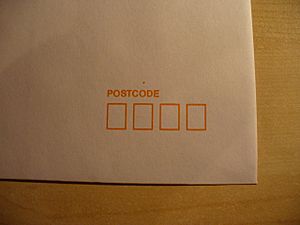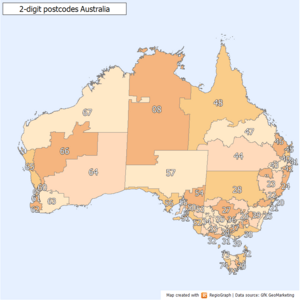Postcodes in Australia facts for kids
Postcodes are special numbers used in Australia to help sort and send mail to the right place. Every postcode in Australia has four numbers. You'll find them at the end of an address. Australia Post, which is the main mail service, manages all Australian postcodes.
You can find postcodes in small books at your local post office. You can also look them up online on the Australia Post website.
Many envelopes and postcards have four orange boxes printed on the bottom right. These boxes are there for you to write the postcode numbers when you address mail by hand.
Contents
History of Postcodes
Postcodes started in Australia in 1967. They were introduced by the Postmaster-General's Department (PMG), which is now known as Australia Post. Before postcodes, mail was sorted using older systems. For example, Melbourne used letter and number codes like N3 or E5. A similar system was also used in country areas of New South Wales.
How Postcodes Look
Australian postcodes always have four numbers. They are written after the name of the city, suburb, or town, and the state or territory.
Here's an example:
- Mr John Smith
- 200 Flinders Street
- MELBOURNE VIC 3000
If you're writing an address by hand, you'll often see four boxes printed on the bottom right corner of many envelopes. These are for the postcode numbers.
Where Postcodes Are Used
Australian postcodes help sort mail by location. Often, one postcode belongs to just one area. For example, 6160 is only for Fremantle, Western Australia.
But sometimes, postcodes can cover many places, especially in country areas. For instance, 2570 covers twenty-two towns and suburbs around Camden, New South Wales. The postcode 3221 for the Geelong Mail Centre in south-western Victoria also includes twenty small places near Geelong. This means mail for these places is fully sorted once it reaches Geelong.
Some postcodes cover many people. For example, 4350 serves about 100,000 people in the City of Toowoomba. Other postcodes cover much smaller populations, even in cities. Postcode numbers range from 0200 (for the Australian National University) to 9729 (for mail to the Gold Coast City Council).
Postcodes for Streets and PO Boxes
Some towns and suburbs have two postcodes. One is for street deliveries, and another is for post office boxes. For example, a street address in the Sydney suburb of Parramatta would look like this:
- Mr John Smith
- 99 George Street
- PARRAMATTA NSW 2150
But if you send mail to a PO Box in Parramatta, you would address it like this:
- Mr John Smith
- PO Box 99
- PARRAMATTA NSW 2124
Postcodes for Big Businesses
Many large businesses, government offices, and other big organisations get a lot of mail. They can have their own special postcode called a Large Volume Receiver (LVR) postcode. For example, the Royal Brisbane and Women's Hospital has the postcode 4029. More LVR postcodes became available in the 1990s.
How Postcodes Are Given Out
Postcodes for States and Territories
The first one or two numbers of a postcode usually show which state or territory it belongs to.
| State/Territory | Abbreviation | Postcode range |
|---|---|---|
| New South Wales | NSW | 1000–1999 (for large businesses and PO Boxes only) 2000–2599 2619–2898 2921–2999 |
| Australian Capital Territory | ACT | 0200–0299 (for large businesses and PO Boxes only) 2600–2618 2900–2920 |
| Victoria | VIC | 3000–3999 8000–8999 (for large businesses and PO Boxes only) |
| Queensland | QLD | 4000–4999 9000–9999 (for large businesses and PO Boxes only) |
| South Australia | SA | 5000–5799 5800–5999 (for large businesses and PO Boxes only) |
| Western Australia | WA | 6000–6797 6800–6999 (for large businesses and PO Boxes only) |
| Tasmania | TAS | 7000–7799 7800–7999 (for large businesses and PO Boxes only) |
| Northern Territory | NT | 0800–0899 0900–0999 (for large businesses and PO Boxes only) |
Sometimes, near state borders, Australia Post finds it easier to send mail through a post office in the next state. This means a postcode might seem to belong to one state, but the actual place is in another.
| Postcode | Suburb | State from Postcode Range | Actual State for this Suburb |
|---|---|---|---|
| 0872 | ERNABELLA | NT | SA |
| 0872 | FREGON | NT | SA |
| 0872 | INDULKANA | NT | SA |
| 0872 | MIMILI | NT | SA |
| 0872 | NGAANYATJARRA-GILES | NT | SA |
| 0872 | FGIBSON DESERT NORTH | NT | WA |
| 0872 | FGIBSON DESERT SOUTH | NT | WA |
| 2540 | HMAS CRESWELL | NSW | Jervis Bay Territory |
| 2540 | JERVIS BAY | NSW | Jervis Bay Territory |
| 2611 | BRINDABELLA | ACT | NSW |
| 2611 | URIARRA | ACT | NSW |
| 2620 | HUME | NSW | ACT |
| 2620 | KOWEN FOREST | NSW | ACT |
| 2620 | OAKS ESTATE | NSW | ACT |
| 2620 | THARWA | NSW | ACT |
| 2620 | TOP NAAS | NSW | ACT |
| 3500 | PARINGI | VIC | NSW |
| 3585 | MURRAY DOWNS | VIC | NSW |
| 3586 | MALLAN | VIC | NSW |
| 3644 | BAROOGA | VIC | NSW |
| 3644 | LALALTY | VIC | NSW |
| 3707 | BRINGENBRONG | VIC | NSW |
Some postcodes cover areas in two different states. For example, postcode 2620 covers a suburb in NSW (Gundaroo) and a suburb in the ACT (Hume). This postcode is within the ACT range.
The Jervis Bay Territory is a special area on the coast of NSW. It shares a postcode with nearby NSW towns. Mail to Jervis Bay Territory is still addressed as if it's in the ACT.
Did you know? The first number of a postcode in each state is the same as the first number used in radio callsigns for that state. For example, 2xx is used in New South Wales, and 3xx in Victoria. Radio callsigns were around long before postcodes!
Postcodes for External Territories
Australia's external territories also use Australia Post's postcode system. Even though these places aren't part of any state, they are addressed as if they are for mail sorting.
| External territory | Postal state | Postcode |
|---|---|---|
| Norfolk Island | NSW | 2899 |
| Christmas Island | WA | 6798 |
| Cocos (Keeling) Islands | WA | 6799 |
Three science bases in Antarctica, run by the Australian National Antarctic Research Expeditions, share a postcode with Macquarie Island. Macquarie Island is a remote island that is part of Tasmania.
| Antarctic base | Postal state | Postcode |
|---|---|---|
| Casey Station | TAS | 7151 |
| Davis Station | TAS | 7151 |
| Mawson Station | TAS | 7151 |
Postcodes for Capital Cities
The postcode for each state's capital city ends with three zeroes. Territorial capital cities end with two zeroes. These were the lowest postcodes in their state or territory.
You can usually change the last "0" to a "1" to get the postcode for General Post Office (GPO) boxes in any capital city. However, Perth now uses a different range of postcodes for its GPO Boxes.
| City | State/Territory | Street Address | GPO Box Address |
|---|---|---|---|
| Sydney | NSW | 2000 | 2001 |
| Canberra | ACT | 2600 | 2601 |
| Melbourne | Vic | 3000 | 3001 |
| Brisbane | Qld | 4000 | 4001 |
| Adelaide | SA | 5000 | 5001 |
| Perth | WA | 6000 | 6837–6848 |
| Hobart | Tas | 7000 | 7001 |
| Darwin | NT | 0800 | 0801 |
Postcodes Within States
While the first number of a postcode shows the state, the second number often shows a region within that state. However, areas with the same second number are not always right next to each other. For example, postcodes from 2200 to 2299 are split between southern Sydney suburbs and the Central Coast of New South Wales.
Postcodes with a second number of "0" or "1" are almost always in the main city area of the state's capital. Postcodes with higher second numbers are usually in country or regional areas. Sometimes, towns that were rural when postcodes started in 1967 have since become part of bigger cities. For example, Penrith, New South Wales has the postcode 2750, and Petrie, Queensland has 4502.
Within each region, postcodes usually get bigger as you travel further from the state's capital city along major roads and railways. Here's an example heading north from Sydney on the North Coast railway:
| Town | Postcode | Distance from Central Station |
|---|---|---|
| Dungog | 2420 | 245 km |
| Taree | 2430 | 378 km |
| Kempsey | 2440 | 503 km |
| Coffs Harbour | 2450 | 607 km |
| Grafton | 2460 | 695 km |
| Casino | 2470 | 805 km |
Postcodes for Major Towns and Cities
Big towns and cities often have "0" as their last number or last two numbers. For example, Rockhampton, Queensland has the postcode 4700, and Ballarat, Victoria has 3350. But there are exceptions. The large town of Ipswich, Queensland has the postcode 4305, while Goodna, a smaller suburb of Ipswich, has 4300.
Postcode Squares on Envelopes
Envelopes sold in Australia often have four boxes in the bottom right corner. Australia Post calls these "postcode squares." They are there for you to write the postcode when you address mail by hand. This helps Australia Post's machines read the postcode using special software called optical character recognition. Postcode squares were first used in 1990.
Australia Post says you shouldn't use postcode squares for mail addressed by a machine or for mail going overseas.
Other Ways Postcodes Are Used
Many other groups and businesses use postcodes too. For example, insurance companies often use postcodes to figure out the cost of car and house insurance. The NSW Ministry of Transport uses postcodes to give unique numbers to each bus stop in Greater Sydney. The stop number is usually five to seven numbers long. The first four numbers are the postcode, and the others identify the specific bus stop. Many companies that make city maps also show postcodes for each suburb.
How Mail Is Sorted by Machines
To make mail sorting even faster, each address now gets a special sorting number. This number is printed on the letter as an orange barcode. This barcode can be up to 12 numbers long. This system helps the post office put mail in the exact order it needs to be delivered.



